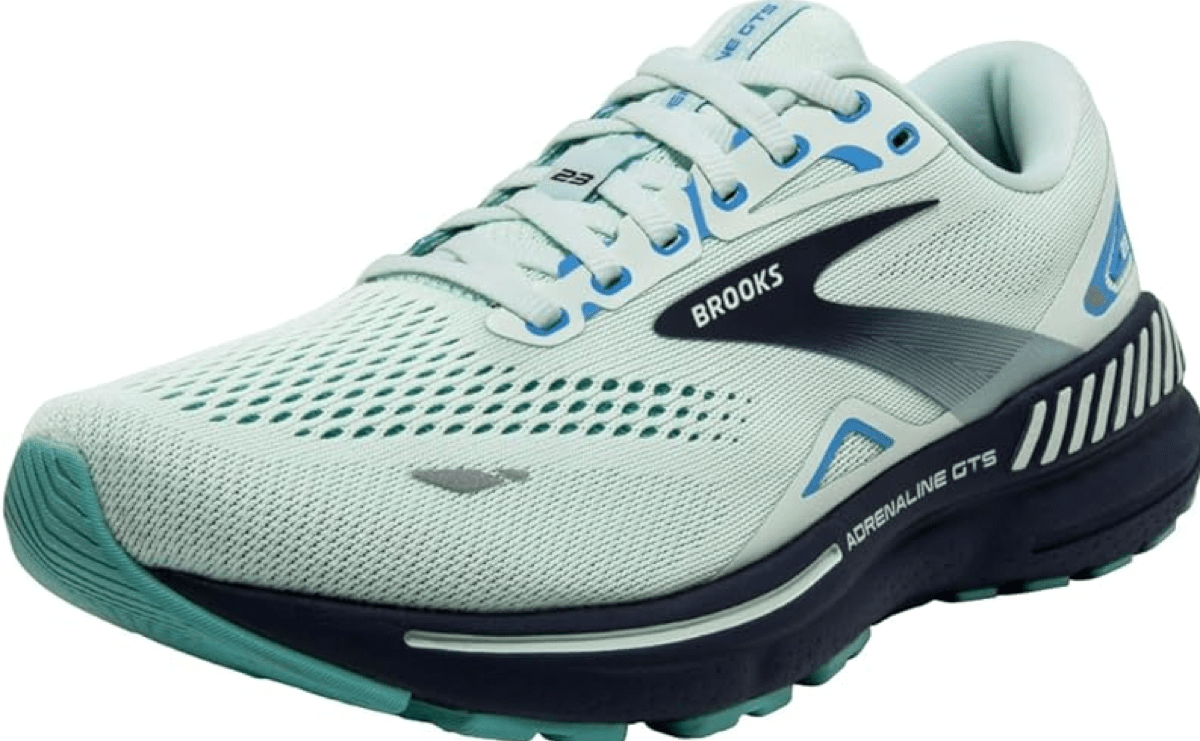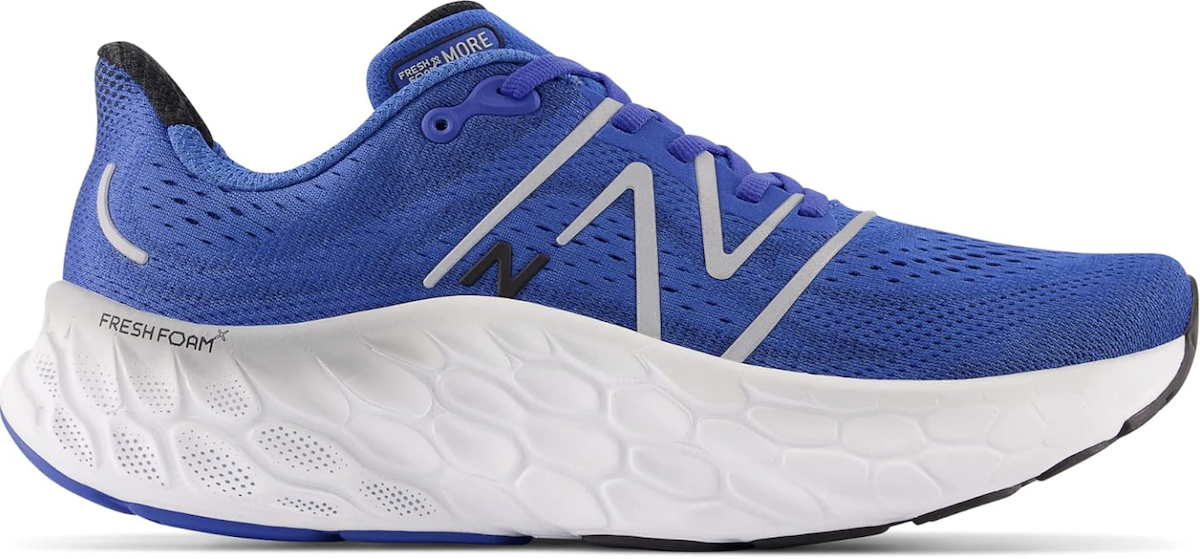The 6 Best Shoes for Walking, According to Podiatrists

Walking is all the rage today, touted for its positive effects on mental health and its role in weight loss. It’s also one of the more affordable exercise plans, as it really only requires you to have a pair of sneakers. Where things get complicated, however, is when it’s time to find a pair that you can truly rely on to get you through your walk without pain or discomfort. Thankfully, experts say there are a few tried and true brands and specific varieties that are well worth the investment. Read on for the six best shoes for walking, according to podiatrists.
RELATED: I’m a Podiatrist, and I’d Never Wear These 3 Pairs of Shoes.
1
Hoka

For all-day comfort while walking or standing, Hoka offers an “ultra-cushioned” line of sneakers with a rear crash pad that helps absorb the shock of your steps.
The popular Hoka Bondi 8 model (it costs $165, but is worth every penny, doctors say) is endorsed with The American Podiatric Medical Association (APMA) Seal of Acceptance.
Ashley Lee, DPM, a podiatrist and foot and ankle surgeon who works with Northern Illinois Foot & Ankle Specialists, says that these are the “ultimate cushioned shoe with a balanced support.” She added that the thick, supportive insole “protects the joint” but that the shoes are still “light enough to walk at a faster pace.”
On TikTok, Megan Ishibashi, DPM, fellowship-trained foot and ankle surgeon at the Palo Alto Medical Foundation, also recommends Hoka, but her pick is the Transport or the Clifton 9.
In a June 5 video, Ishibashi notes that the Transport is her “personal favorite,” while the Clifton 9 is “a little more supportive” and has “a thicker sole.”
2
Brooks

Another classic runners’ brand, Brooks is known for its high-quality sneakers that offer support, comfort, and protection in a wide range of styles. Even better, they offer features like shock absorption, arch support, and breathable materials.
“I highly recommend considering them when searching for the best walking shoes,” shares Daniel Pledger, a podiatrist and founder of ePodiatrists.
He adds, “What makes the brand stand out is their commitment to providing the best fit and support for the feet. They invest in research and development to constantly improve their products and offer a variety of widths and sizes to ensure a proper fit for every foot type. Additionally, their walking shoes are designed with durable materials to withstand daily wear and tear, providing long-lasting comfort for the feet.”
3
Orthofeet

While you may not have heard of Orthofeet, I can personally attest to the comfort of these walking shoes.
I was gifted a pair of the Wander Hands-Free sneakers in white, and they’ve quickly become my go-to sneakers. Not only are they comfortable and cute, but they’re also extremely helpful for my plantar fasciitis, which causes my feet to ache if I wear unsupportive shoes for too long.
I walked almost 6 miles in a pair of these (with existing blisters from a pair of aforementioned unsupportive shoes I wore the night before), with no discomfort during or after. I recommend these if you’re looking for more of a fashion sneaker to create a more elevated look without sacrificing your foot health. But I’m not a doctor, so it’s worth noting that podiatrists recommend Orthofeet shoes to patients as well.
“I have been offering patients Orthofeet shoes for 6+ years and my patients, both diabetics and non-diabetic, have found them to be comfortable and stylish,” Jeffrey Gewirtz, DPM, medical director of Curalta Health, wrote in a review on the Orthofeet website.
4
On

The popular Swiss contenders, On sneakers, have been spotted on chic feet for a while now. The brand is unique for its patented CloudTec cushioning technology: tiny pods (“clouds”) on the soles that compress with each step to absorb impact. On is also known for the convenient speed lacing system that uses elastic laces so you can slip the shoes on and off quickly and easily.
“One of the reasons that On Cloud is great for walking or standing all day is the design of the shoe provides more stability to the foot for leg alignment. That’s going to prevent a lot of aches and pains from knees or ankles falling inward,” Amanda Brooks, certified running coach and editor of the Run to the Finish blog, tells Best Life.
“On Cloud is going to provide you with support, average weight, and moderate cushion. In fact, I actually prefer most On running shoes for walking!” Brooks says.
Ishibashi specifically recommends the On Cloudmonster as a choice that’s both “sleek” and “cushioned,” with a thick sole and rocker bottom.
“My husband has a pair and is a huge fan,” she writes in text overlaying her recent TikTok video.
RELATED: 6 Tips for Wearing Flats If You’re Over 60, According to Stylists and Podiatrists.
5
New Balance

Podiatrists also recommend New Balance shoes for walking. The brand itself is having somewhat of a renaissance—who knew that the quintessential “dad shoe” would be all the rage? But in addition to being a trendy, stylish choice, doctors say that they’re also just comfy.
Hira H. Mirza, DPM, MSc, a Houston-based podiatrist, calls the New Balance 530 “chef’s kiss” in an Aug. 6 TikTok video.
“They look cute with outfits and are very supportive,” she says.
In her video, Ishibari adds that New Balance sneakers are also good for “long walks throughout the city or just for exercise.”
The “lesser known sister” of the 530 is the Fresh Foam X More v4, which Mirza says is also good for walking.
6
Asics

Another sneaker to consider for your walking routine are Asics. Mirza cites the Asics Gel-1090v2 as her “favorite Asics.”
She adds, “They’ve never failed me. I could go on like a 10-mile walk in these—no pain.”
For Ishibari, the Gel-Cumulus 25 is another good option.
“Very much an athletic sneaker but tried and true walking shoe,” she writes.